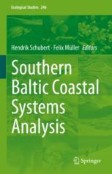Search
Search Results
-
A meta-analysis of benthic rotifer community structure as a function of lake trophic state
Our understanding of the ecological drivers that control community structure of benthic rotifers is poorly known. By reviewing 21 papers on...

-
Community dynamics of microbial eukaryotes in intertidal mudflats in the hypertidal Bay of Fundy
Protists (microbial eukaryotes) are a critically important but understudied group of microorganisms. They are ubiquitous, represent most of the...

-
Integrating seascape resistances and gene flow to produce area-based metrics of functional connectivity for marine conservation planning
ContextPrioritizing regions that facilitate connectivity among populations is an essential principle for conservation planning. However, the lack of...

-
Influence of the Fish Introduction in Lakes of the Arid Southern Patagonia
Rainbow trout (Oncorhynchus mykiss) was introduced in most lakes of Patagonia, generating concern about its impact on the receiving communities....
-
Penguins and Seals Transport Limiting Nutrients Between Offshore Pelagic and Coastal Regions of Antarctica Under Changing Sea Ice
Large animals such as sea birds and marine mammals can transport limiting nutrients between different regions of the ocean, thereby stimulating and...

-
Mating Systems
Males and females have evolved a particular set of tactics and strategies, or mating systems, to find and successfully inseminate or be inseminated...
-
Long-Term Trends of the Offshore Ecosystems
Long-term data sets are crucial in assessing the state of the marine systems and its ecological processes, to disentangle human-induced and natural...
-
Diel changes in structure and trophic functions of motile benthic invertebrates on coral reefs at Rapa Nui (Easter Island)
Coral reefs are structurally complex habitats that provide diverse shelter for motile benthic invertebrates (MBI), including those with cryptic and...

-
Population niche breadth and individual trophic specialisation of fish along a climate-productivity gradient
A mechanistic understanding of how environmental change affects trophic ecology of fish at the individual and population level remains elusive. To...

-
Develo** Cultivation Systems and Better Management Practices for Caribbean Tropical Seaweeds in US Waters
At the time of writing, the Caribbean’s small countries and island nations were experiencing a loss of resources resulting from climate change,...
-
Benthic scavenger community composition and carrion removal in Arctic and Subarctic fjords
In high latitude coastal regions, benthic scavenger communities are largely composed of invertebrates that play a key role in the cycling of organic...

-
Habitat complexity in shallow lakes and ponds: importance, threats, and potential for restoration
In this review we describe patterns and mechanisms by which habitat complexity is crucial for the functioning of shallow lakes and ponds, and for the...

-
Habitat coupling mediated by the multi-interaction network linked to macrophyte meadows: ponds versus lakes
Morphometric differences between ponds and lakes have implications in habitat-dimensioning and coupling. The prevalence of pelagic over benthic...

-
Flexible foraging strategies in a highly pelagic seabird revealed by seasonal isotopic niche variation
Flexibility in foraging strategy is an important mechanism by which seabirds cope with spatiotemporal heterogeneity in food availability and the...

-
Mysis segerstralei, an unexpected but important prey for resident Arctic charr (Salvelinus alpinus) in a Svalbard lake
Mysis segerstralei is distributed over a wide geographic area and in habitats with a variety of salinity conditions, including marine and brackish...

-
Temporal and spatial distribution of macrozoobenthos in three lakes of different trophic states: a case study of the Narochianskie lakes (Belarus)
We used macrozoobenthos data (abundance, biomass, and community structure) spanning 69 years including annual surveys from 1997 to 2016 in three...

-
Dreissena in the Great Lakes: what have we learned in 30 years of invasion
We summarized over 30 years of research on zebra and quagga mussels in the Laurentian Great Lakes and compared with data from European and North...

-
Comparative phylogeography and demographic histories of five widely distributed tropical eastern Pacific fishes
The tropical eastern Pacific (TEP) has been divided into several biogeographic provinces separated by two types of habitat gaps: stretches of sandy...

-
Potential effects of warming on the trophic structure of shallow lakes in South America: a comparative analysis of subtropical and tropical systems
To investigate the potential long-term consequences of environmental warming in subtropical systems, we compare the trophic structure of shallow...

-
An Outlook on Marine Sponges and Associated Biodiversity Addressing Conservation Strategies
Sponges are the pore-bearing animals belonging to the phylum Porifera. They are the oldest living multicellular invertebrates on this planet. Sponges...
